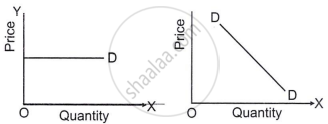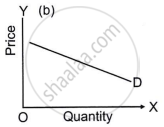Advertisements
Advertisements
प्रश्न
A perfectly elastic demand curve is parallel to the X-axis. Why or why not?
उत्तर
A perfectly elastic demand curve is parallel to the X-axis because the buyers are willing to buy any quantity at a given price.
APPEARS IN
संबंधित प्रश्न
Define the form of market which has a perfectly elastic demand curve.
Which is the implication of a horizontal demand curve?
Match the following and select the correct option.
| Column I | Column II | ||
| (i) | Perfectly elastic demand | A. | Ed = 0 |
| (ii) | Perfectly inelastic demand | B. | Ed = ∞ |
| (iii) | Relatively elastic demand | C. | Ed < 1 |
| (iv) | Relatively inelastic demand | D. | Ed > 1 |
Match the following:
| Column I | Column II |
| A. Perfectly Elastic | (i) Ed = 0 |
| B. Perfectly Inelastic | (ii) Ed = infinity |
| C. Highly Elastic | (iii) Ed < I |
| D. Less Elastic | (iv) Ed > I |
For each of the following, state whether it has inelastic demand or elastic demand:
- Luxury cars
- Life saving drugs
- Salt
- English textbook of class X
Indicate the degree of elasticity of demand of the following demand curves.

Why is market demand curve more elastic than an individual demand curve?
Indicate the degree of elasticity of demand of the following demand curve.

What is the price elasticity of demand for the following demand curve:
Straight line demand curve parallel to Y-axis.
What is the price elasticity of demand for the following demand curve:
Rectangular hyperbola.
